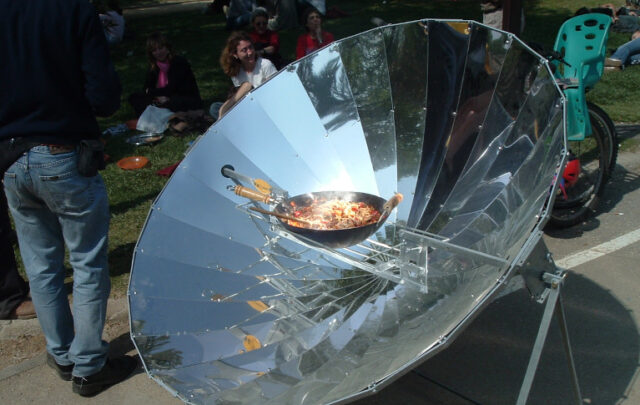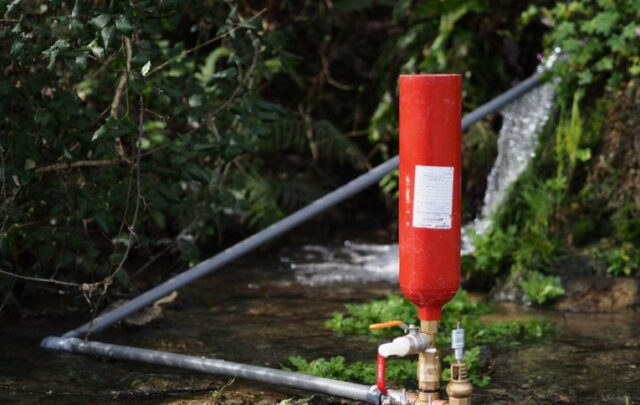NOTE: Images in this archived article have been removed.
This article is from a talk given at the Senator George J. Mitchell Center for Sustainability Solutions at the University of Maine on September 14, 2015.

Two views image via shutterstock. Reproduced at Resilience.org with permission.
“Sustainability” has become the master term for discussing visions for the future, in a world where the future is looking much less certain than it was a couple of generations ago. I used to think that the term had become meaningless because it’s used in so many different ways. But after studying its evolution I now think sustainability is indeed a useful term, precisely because it accommodates a diversity of worldviews, as well as expressing uncertainty about our future.
In this essay I explore how assumptions of nature’s Scarcity and Abundance underlie our visions of sustainability, and our prescriptions for action. Given my work over the last 20 years on sustainable production and consumption, I focus on material aspects of sustainability, including products as embodied energy and the roles of production, consumption and disposal of products in the search for sustainable solutions. Finally, I survey visions of sustainability based on Scarcity and Abundance, and real-world movements that address sustainable production and consumption.
Scarcity, Abundance and Sustainability
Scarcity was taken for granted throughout most of human history. It was a common assumption that nature was fundamentally constituted by scarcity, if not outright nastiness. For example, the Bible mentions “wilderness” some 300 times and not one of them is positive.
Scarcity was a fundamental assumption and thrift was a core value — in numerous forms, not just the sense of frugality. This is detailed at length in a fascinating book,
Thrift and Thriving in America: Capitalism and Moral Order from the Puritans to the Present, co-edited by Joshua Yates and James Davison Hunter. For example, American Puritans held thrift to be a spiritual value located in the community; while in the Victorian era individual frugality was the basis of middle-class respectability.
But all that changed with the discovery of a seemingly limitless source of concentrated energy: fossil fuels. By the 20th century much of mankind witnessed a radical reversal of the assumption of Scarcity. The greatest economic expansion in the history of humankind laid the groundwork for the new ethic of consumption, which gradually supplanted the ethic of thrift.

Figure A: U.S. Households Containing Various Consumer Goods, 1900– 2000.
SOURCE: J. R. McNEILL AND GEORGE VRTIS, 2012
What people saw for the first time in history were the abundant fruits of technology within reach of almost everyone. In the US, saturation of consumer appliances – all produced, delivered and operated by fossil fuels – illustrates the story. Figure A shows the percentage of US households owning various consumer goods like radios, refrigerators and televisions over the course of the 20th Century, and the dates by which virtually all households had them. It’s a similar picture for personal automobiles, for cell phones, and lots more.
Faith in Abundance reflected faith in modernization and progress and a deep-seated belief that these forces had rendered obsolete the condition of Scarcity. As Yates observed in
Abundance on Trail:
“Increases in longevity, reductions in mortality, ever-higher standards of living, greater freedoms for greater numbers and classes of people—the evidence was obvious for all to see. … “Even two World Wars, a planet-wide Great Depression, and the specter of atomic destruction… could not completely dampen the facts of modern progress.”
But soon the costs of the new Abundance started coming into view. By the 1970s, awareness of pollution, overpopulation and social ills intruded on our faith in modernization, progress and Abundance. Advertisements, like this one
from Life Magazine in 1956 touting the purity of motor oil, now seemed shockingly naive.
By the 1990s the specter of climate change and its evil twin, ocean acidification, really got our attention. And it became clear that numerous interconnected trends were increasing. The
International Geosphere-Biosphere Programme documented a
Great Acceleration of numerous trends, noting that “[m]any human activities reached take-off points sometime in the 20th Century and sharply accelerated towards the end of the century.”
In response, key terms associated with modernization and progress came into serious question. Industrialization, urbanization, and mass consumption were no longer seen as the unmitigated good things they once were taken to be. An Abundant future now seemed less certain.
In the midst of this uncertainty the term sustainability came into widespread use.
The concept of ecological sustainability is pretty straightforward. It’s the condition in which the throughput materials and energy in an ecosystem can go on indefinitely. But sustainability of humans is more complicated. From the outset, ecological
sustainability was combined with concepts of social equity and economic growth in the post-colonial term
development. The 1987 Brundtland Commission report,
Our Common Future, defined sustainable development as “development that meets the needs of the present without compromising the ability of future generations to meet their own needs.” In this formulation the concepts of ecological sustainability and economic growth are uneasy bedfellows, a topic I will come back to.
Products and Energy
First let’s narrow our focus to sustainability of materials, and more specifically, to the production and consumption of manufactured products. If sustainability is the master term for the concerns of our time, then climate change is the master problem. And the current climate crisis is primarily the result of burning fossil fuels since the dawn of the industrial revolution. While climate change has everything to do with energy use, it’s also true that climate change is largely a function of the production, consumption and disposal of material goods made possible by burning fossil fuels.
Physicists have long understood that energy and matter are two sides of the same coin. And ecologists understand that ecological sustainability is a function of the throughput of both energy and materials through the biosphere. But people and governments have been slower to grasp the connection. In the realm of materials, the analogous concept is that products embody energy. In particular, manufactured products embody the energy – mostly from burning fossil fuels – it took to extract, harvest, transport, manufacture, and sell the items in question.
One way of looking at greenhouse gas emissions is to ask the question, ‘What’s the ultimate function of burning fossil fuels?’ And the surprising answer is that the largest fraction of greenhouse gas emissions is directly or indirectly related to the production, consumption and disposal of manufactured goods, or products.

Figure B: US greenhouse gas emissions from products
SOURCE: Product Policy Institute, 2009
Several years ago the
US EPA determined that 37% of US greenhouse gas emissions were due to the production and consumption of goods. That’s shown in
Figure B by the blue bar on the left. Note that it’s larger than the other blue bars, which show greenhouse emissions associated with heating, lighting, passenger transport and food. At the same time that EPA released its findings, in 2009,
UPSTREAM commissioned and released the findings of a parallel analysis, conducted by the same EPA contractor. This analysis included all emissions, including “outsourced” emissions, which are emissions released abroad to make products consumed in America. The result was that even more — 44% — of all US greenhouse gas emissions are related to the production and consumption of manufactured products. This is shown in the figure by the tall red bar on the left. Again, that’s more than the activities get the get the lion’s share of attention in programs aimed at reducing greenhouse gas emissions: heating and cooling or personal transportation.

Cartographic depiction of toy exports.
SOURCE: JOHN BARRETT,STOCKHOLM INSTITUTE 2010.
Here’s a cartographic depiction of the production and consumption of
one product category, toys. Most toys in the world are produced in Asia which has more polluting factories that emit relatively more greenhouse gas. In the top image, the areas are drawn to show the relative distribution of toy manufacturing, with Asia shown in green. But the lion’s share of toys are bought and used in the US, as is shown in the bottom image. The result is that we in the US are outsourcing our carbon emissions to Asia.
Analyses done at the state and city level show a similar connection between material consumption and greenhouse gas emissions. Data from
King County, Washington, home of Seattle, show that out of 55 million tons of carbon dioxide equivalents released in 2008 by the residents, almost three quarters (73%) were due to emissions from producers, pre-purchase transport, and selling activity (
Figure C). That’s a lot of embodied emissions.

Figure C: King County, WA Consumption and GHG Emissions.
SOURCE: KING COUNTY, 2012.
Which materials are causing the most problems for climate change, and hence the biggest challenges for sustainability? An important distinction in the world of materials management is manufactured products and organic materials. Or to use
Annie Leonard’s popular language: made stuff and grown stuff. Products, including things like paper that are made from grown stuff, are generally recycled. Organics are generally composted. Industrial-scale processed food is a hybrid: while it starts out as something grown, industrial agriculture and processing make many packaged foods similar to other manufactured products in terms of ecological impacts.

Figure D: The Rise of Products, 1900-2000.
SOURCE: Product Policy Institute, 2005.
When we look at what Americans throw away, and what has been managed by local governments over the last century, we see a striking pattern. One hundred years ago most of the discards collected by municipalities from households were inorganic coal ash used for heating and cooking (shown in grey in Figure D), along with organic food scraps (shown in green). Manufactured products (shown in red) were relatively simple things like paper and glass. Fast-forward 60 years and we see coal ash had become an industrial responsibility; organic discards had risen somewhat due to suburbanization; but what really shot up was manufactured products. Fast-forward another 40 years and we see the trend has only increased. Over the course of the 20th century, products increased 10-fold as a portion of municipal solid waste, from 7% to 70%.

Figure E: SOURCE: US EPA “Municipal Solid Waste in the US: 2012 Data”
Manufactured products today are much more complex and diverse than 100 years ago, and products travel in global supply chains. The poster child for modern materials – good and bad — is plastics. The spectacular rise of plastics (shown in Figure E), its diverse uses, and the benefits they bestow are mind-boggling. I for one love my polyester hiking clothes. At the same time they are made from the fossil fuels that are driving climate change, they’re almost synonymous with disposability (note the trivial recovery rate in this graph), they spread toxins globally, and are responsible for massive ocean pollution that is just starting to come into focus.
The bottom line is that when we talk about the roles of mass consumption and consumerism as contributors to climate change, it is manufactured products made in a globalized economy that are at issue. Let’s look next at historical efforts to mitigate the negative impacts of manufactured products.
Production, Consumption, Disposal … and Growth
Economies have traditionally been conceptualized in terms of systems of production, consumption, and disposal. I’m using disposal to mean whatever happens to products and organic materials when consumers are done with them, whether they are repaired, reused, recycled, composted, landfilled, incinerated, or anything else. In terms of sustainability, we can see an historical arc moving from focus on disposal, to consumption, and on to production – and now even to questioning the entire system.
Disposal. The practices of disposing the fruits of our mass consumer economy have developed over the last century in the context of the Abundance worldview. Discards have been a given, and the key question has been one of engineering: how to “get rid of” them in the most efficient and cost-effective way. In the United States, local governments act in much of the country as service providers for collecting both trash and recyclables, especiallyfromresidences; elsewhere they oversee franchises and contracts to ensure that the job gets done.
It’s interesting to note that the municipal solid waste management system evolved in cities
a century ago when horse manure and dead animals were a major health problem, and coal ash was the primary solid waste, as we saw in
Figure D. Both were relatively simple, homogenous waste streams. This was before the explosion of manufactured products, with all their complexity, diversity, toxicity and volume. Some have argued that government is poorly suited to managing highly diverse manufactured discards and marketing them in global commodity markets; and that this has led to an overemphasis on garbage disposal by municipalities. An intriguing, and largely unexplored question, is the extent to which the provision, to producers by local governments, of unlimited “free” disposal services for manufactured products, has enabled the production of goods designed for rapid obsolescence — and to our throwaway society generally.
Given the embodied energy in products, one might think that burning trash would be a sustainable solution. But it’s not. Municipal waste incinerators release
two and a half times more carbon dioxide than natural gas power plants, according to the US EPA. And compared with recycling, burning trash recovers far less energy than recycling saves.
Jeffrey Morris has performed numerous life cycle analyses for dozens of material categories over the last 20 years. He’s found that for virtually every material, recycling saved on average 4 times as much energy as “waste-to-energy” incineration recovered. Burning trash for energy is like burning the furniture to heat your house.
Consumption and the 3 Rs. The fruits of mass consumption have been so massive as to elicit calls for conserving resources, which of course is a function of the Scarcity worldview. This concern gave rise to the 3Rs prescription – Reduce-Reuse-Recycle — which provided an outlet to those consumers concerned about thrift. The 3Rs were framed as the upper part of a “waste management hierarchy” in which all consumer discards were considered waste, and Reduce-Reuse-Recycle was supposed to precede burying and burning. Being a hierarchy, reducing consumption was supposed to come before reuse, and reuse before recycling – with landfilling and incineration only used as a last resort. So how have we done?

Figure F: US Wasting and Recycling since 1960.
SOURCE: US EPA “Municipal Solid Waste in the US: 2010 Data”.
Actually, not so well. In the US, most municipal discards wind up as garbage and are buried or burned — between 60 and 70% in most states. Figure F shows the percentages of discards wasted and recycled (including composting) since 1960. The red oval shows the decade when local governments first made huge investments in curbside recycling programs. But only about a third of our discards are recycled, the opposite of the solid waste hierarchy. And recycling rates have been stagnant for a generation.
Reuse has gotten such short shrift that we don’t even have good measurements for it. And, source reduction is so out of tune with the prevailing Abundance worldview that it barely gets seriously talked about.
In fact,
EPA’s idealized image of the waste hierarchy is the exact opposite of how we are actually managing waste. Most discards are buried or burned, less is recycled, even less reused. The picture of actual tonnages reused, recycled and wasted is the opposite of the EPA waste hierarchy because financial incentives are the exact opposite. Incentives for wasting are greatest, recycling is next, and reuse is a distant third.
There’s another thing about the focus on consumers and recycling. From the perspective of sustainable solutions, focusing on consumption
implicitly blames consumers and leads to the presumption that better individual purchasing decisions and recycling behavior can lead to sustainability. But there’s little evidence that this can work and much that it doesn’t.
Production. Many in business and government are realizing that we can’t make disposal and consumption more sustainable without addressing the design and production of goods. I’ve been working for the last decade and a half on a policy approach called
extended producer responsibility, or EPR, in which producers’ responsibility for their products is extended to the whole life of the products, including when consumers are done with them. The policy approach originated in Europe in the 1990s and has become well-established there and in Canada. In the US we’ve managed to pass almost
60 state EPR laws for more than a dozen product categories since 2004. But the devil is in the details and many EPR laws leave much to be desired; and the policy approach has met a great deal of resistance in the US. In any case, these laws are not a silver bullet for making production sustainable. We still have a long way to go.
In sum, many noble efforts to address sustainability have been made at the level of disposal, consumption and production. Small gains have been made, but too few big successes to date. Let’s step back, then, and ask: Which part of the production-consumption-disposal cycle is a root cause of climate change? Is it:
- Lack of recycling infrastructure or landfill space?
- Imperfect consumer behavior? or
- Poor product design?
While each of these are contributing factors and need to be part of the solution, I think the fundamental problem lies deeper. The core problem may lie with the assumption that unlimited growth can be sustainable. It seems to be a bedrock assumption of most businesses, governments and economists the world over that consumption and population can increase indefinitely, and that growth is necessary, inevitable and desirable. Increasingly, that assumption is being questioned by some of those working towards a sustainable future.
Competing Visions of Sustainability
Let’s return to the Scarcity and Abundance worldviews in the context of sustainable production and consumption, and briefly examine two active movements that offer very different remedies for what ails our current material culture. I actually believe that the Scarcity and Abundance worldviews are part of a continuum of visions for sustainability — from those rooted in varying degrees in the Abundance worldview, to others informed more by assumptions of Scarcity.
Abundance Visions. Those at the Abundance end of the continuum tend to be optimistic about human ability to solve problems using technology and innovation. Hence they’ve been called techno-optimists and eco-modernists. At the extreme end are climate change deniers. But in truth, most of those who hold the Abundance worldview believe that our climate is changing and our situation is serious. Their perspectives range from a reluctant “We’ve messed up the planet, now let’s learn to manage it,” to an eager embracing of technology, and even talk of a ‘Good Anthropocene.’ Two examples:
- The Breakthrough Institute is at the forefront of the latter way of thinking. Ted Nordhaus and Michael Shellenberger, lead authors of the recent Eco-modernist Manifesto, argue for embracing technology like nuclear energy and GMO crops to “intensify human activities — particularly farming, energy extraction, forestry and settlement — so that they use less land and interfere less with the natural world.”
- Cradle-to-Cradle co-author Bill McDonough is another proponent of the Abundance worldview. Ten billion people? Not a problem. Unleash innovation and we can redesign everything so it can be “upcycled,” there is no waste, and everyone can thrive.
The “movement” that best reflects the Abundance mindset
and addresses sustainable production and consumption is the Circular Economy Movement. While the term
circular economy is not new, it’s been effectively popularized by Ellen MacArthur and her foundation in the UK. Established only five years ago, the
Ellen MacArthur Foundation has created a huge buzz in Europe, especially in business circles. It’s been a perennial topic at the World Economic Forum in Davos; and recently even the
European Commission has started talking about circular economy goals.
The circular economy is ultimately about reforming the current industrial system. Primary emphasis is on engaging business leaders because, it’s argued, only large corporations have the resources and agility to move fast enough and far enough to make a difference in solving the big problems humanity faces. Business leaders tend to be optimistic about the future and to believe that technology and innovation can solve most problems without government regulation. They are probably drawn to the circular economy movement because it
does not call for slowing rates of economic growth or consumption – that is, for selling fewer products — but rather for making products and product systems more efficient.
The Circular Economy feels to me somewhat like the civic
Zero Waste movement that I helped launch 20 years ago. Zero Waste? Circular Economy? What’s not to like? One comes from the Scarcity worldview, the other from the Abundance worldview. In and of themselves, both are visionary and apolitical.
Scarcity Visions. At the other end of the Abundance-Scarcity continuum are those who believe that humanity’s situation is more dire and calls for deeper changes. Relying on hope and techno-fixes that will allow us to continue living how we’re living in the face of catastrophe is delusion, they believe.
Nobody has framed it better than Naomi Klein. In her book
This Changes Everything she makes the argument that much of the resistance to acting on climate change arises because global warming requires government regulation and limiting material growth. A strong moral case for action was recently made by Pope Francis in his June 2015 encyclical,
Laudato Si. Like Klein, the Pope emphasizes that unending material growth has a disastrous side, especially for the poor. What’s needed is a radical transformation of political and economic institutions.
It’s tempting to paint the Scarcity worldview as simply knee-jerk pessimism. And you might get that impression from images like the one on the cover of a book by Richard Heinberg,
The Party’s Over. In fact, a third of the world’s people have had our fossil fuel party, while another third hasn’t even started. Heinberg, founder and senior fellow at the
Post Carbon Institute in California, believes that our fossil-fueled economy is going to end, one way or another, within a few decades. And we will have to transition to renewable energy sources which will mean a radically lower and therefore more localized energy mode of existence.
But actually Heinberg and a lot of other scholars and activists are focusing these days on thinking through how people can adapt and thrive in a world without fossil fuels. There’s a great deal of activity, both theoretical and practical, on what Tim Jackson calls “
prosperity without growth.” This line of thinking is based on the idea that Abundance does not have to be defined solely in materialistic terms. Abundance can also be defined in terms like Abundant health, satisfaction and joy. (Which kind of muddies our neat Scarcity-Abundance dichotomy, doesn’t it?) Much of the academic work is being networked by the
Sustainable Consumption Research and Action Initiative.
The sustainability “movement” that best reflects the Scarcity mindset and addresses production and consumption is the New Economy Movement. Actually, it is more of a frame of mind than a coherent movement. It seeks to replace consumerism with values like happiness, resourcefulness and equality; and global capitalism with resilient local economies.
Gar Alperovitz has written that the New Economy movement is “a far-ranging coming together of organizations, projects, activists, theorists and ordinary citizens committed to rebuilding the American political-economic system from the ground up. … It involves thousands of real world projects — from solar-powered businesses to worker-owned cooperatives and state-owned banks. Many are self-consciously understood as working prototypes that may be applied at regional and national scale when the right political moment occurs.”
The organization in the US attempting to coordinate this diverse assemblage is the
New Economy Coalition. It was created in 2013 from a merger of two other organizations and is affiliated with the
New Economics Foundation in the UK.
Conclusion
I find it fascinating how the word sustainability is used in so many different ways, and how our visions for the future are informed by our worldviews of Scarcity or Abundance. The Abundance worldview seems to be associated more with interventions at the Production stage of the industrial system, while the Scarcity worldview tends to focus more on the Consumption stage.
Moreover, the Abundance worldview seems to correlate strongly with business values, which Jane Jacobs, in
Systems of Survival, called the Commercial Moral Syndrome. Commercial values are based on trading which in turn relies on competition, innovation and voluntary actions. The Scarcity worldview seems to correlate more strongly with values characteristic of government, which Jacobs called the Guardian Moral Syndrome. Guardian values are based on the need to defend and protect communities and territory. They rely on responsibility, tradition and enforcement.
Jacobs concluded that both moral syndromes are needed for a healthy society. I believe that we need both radical innovation from business, and strong government action in the public interest if we are going to build resilient communities and systems that can thrive in the face of climate disruption.
Bill Sheehan, Ph.D., is Founder, UPSTREAM and a Post Carbon Fellow.














